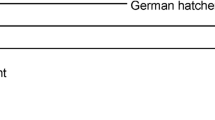Abstract
Black scraper is a commercially important oceanodromous fish in Korea. The commercial catch of this fish has decreased continuously since 1990. However, its genetic characteristics have never been studied. For population genetic analysis to assist effective aquaculture and stock management efforts, we isolated and characterized 19 microsatellite loci using an microsatellite-enrichment method based on magnetic/biotin capture of microsatellite sequences from a size-selected genomic library. To characterize each locus, 30 individuals from a natural T. modestus population in southern Korea were genotyped. All loci except two, KTm213 and KTm284, were polymorphic, with an average of 15.18 alleles per locus (range, 2–41). The mean observed and expected heterozygosities were 0.67 (range, 0.33–0.97) and 0.79 (range, 0.40–1.00), respectively. A significant deviation from Hardy-Weinberg equilibrium was observed at six loci (KTm142, KTm145, KTm158, KTm24, KTm221, and KTm250). This high variability indicates that these microsatellites may be useful for high-resolution studies of population genetics.
Similar content being viewed by others
References
An, HS, Park JY, Kim M-J, Lee EY and Kim KK (2009) Isolation and characterization of microsatellite markers for the heavily exploited rockfish Sebastes schlegeli, and cross-species amplification in four related Sebastes spp. Conserv. Genet. 10: 1969–1972.
Asahida T, Kobayashi T, Saitoh K and Nakayama I (1996) Tissue preservation and total DNA extraction from fish stored at ambient temperature using buffers containing high concentrations of urea. Fish. Sci. Tokyo. 62: 727–730.
Carleton KL, Streelman JT, Lee BY, Garnhart N, Kidd M and Kocher TD (2002) Rapid isolation of CA microsatellites from the tilapia genome. Anim. Genet. 33: 140–144.
DeWoody JA and Avise JC (2000) Microsatellite variation in marine, freshwater and anadromous fishes compared with other animals. J. Fish. Biol. 56: 461–473.
Excoffier L, Laval G, Schneider S (2005) ARLEQUIN version 3.0. An integrated software package for population genetics data analysis. Evol. Bioinform. Online 1: 47–50.
Gardner MG, Cooper SJB, Bull CM and Grant WN (1999) Isolation of microsatellite loci from a social lizard, Egernia stokesii, using a modified enrichment procedure. J. Hered. 90: 301–304.
Guo S and Thompson E (1992) Performing the exact test of Hardy-Weinberg proportion for multiple alleles. Biometrics 48: 361–372.
Hamilton MB, Pincus EL, DiFiore A and Fleischer RC (1999) Universal linker and ligation procedures for construction of genomic DNA libraries enriched for microsatellites. BioTechniques. 27: 500–507.
Hauser L, Adcock GJ, Smith PJ, Bernal Ramirez J and Carvalho GR (2002) Loss of microsatellite diversity and low effective population size in an overexploited population of New Zealand snapper. Proc. Natl. Acad. Sci. USA 99: 11742–11747.
Hoarau G, Boon E, Jongma DN, Ferber S, Palsson J, Van der Veer HW, Rijnsdorp AD, Stam WT and Olsen JL (2005) Low effective population size and evidence for inbreeding in an overexploited flatfish, plaice (Pleuronectes platessa L.). Proc. Biol. Sci. 7: 497–503.
Hutchinson WF, Carvalho GR and Rogers SI (2001) Marked genetic structuring in localised spawning populations of cod Gadus morhua in the North Sea and adjoining waters, as revealed by microsatellites. Mar. Ecol. Prog. Ser. 223: 251–260.
Kim M-J, An HS and Choi KH (2010) Genetic characteristics of Pacific cod populations in Korea based on microsatellite markers. Fishe. Sci. 76: 595–603.
Kim PD (2007) Miniature guide to whole Korean fishes. Scuba Diver 1: 215.
Kim WJ, Kim KK, Lee JH, Park DW and Lee JY (2003) Isolation and characterization of polymorphic microsatellite loci in the olive flounder (Paralichthys olivaceus). Mol. Ecol. Notes 3: 491–493.
Li Q, Park C and Kijima A (2002) Isolation and characterization of microsatellite loci in the Pacific abalone, Haliotis discus hannai. J. Shell. Res. 212: 811–815.
Nikolic N, Fève K, Chevalet C, Høyheim B and Riquet J (2009) A set of 37 microsatellite DNA markers for genetic diversity and structure analysis of Atlantic salmon Salmo salar populations. J. Fish Biol. 74: 458–466.
Pemberton JM, Slate J, Bancroft DR and Barrett JA (1995) Nonamplifying alleles at microsatellite loci: a caution for parentage and population studies. Mol. Ecol. 4: 249–252.
Portnoy DS, Renshaw MA, Hollenbeck CM and Gold JR (2010) A genetic linkage map of red drum, Sciaenops ocellatus. Anim. Genet. 41: 630–41.
Rice WR (1989) Analyzing tables of statistical tests. Evolution 43: 223–225.
Ruzzante DE (1998) A comparison of several measures of genetic distance and population structure with microsatellite data: bias and sampling variance. Can. J. Fishe. Aqu. Sci. 55: 1–14.
Selkoe KA and Toonen (2006) Microsatellites for ecologists: a practical guide to using and evaluating microsatellite markers. Ecol. Letters 9: 615–629.
Serbezov D, Bernatchez L, Olsen EM and Vøllestad LA (2010) Mating patterns and determinants of individual reproductive success in brown trout (Salmo trutta) revealed by parentage analysis of an entire stream living population. Mol. Ecol. 19: 3193–205.
Tautz D (1989) Hypervariability of simple sequences as a general source for polymorphic DNA markers. Nucl. Acids Res. 17: 6463–6471.
van Herwerden L, Choat JH, Dudgeon CL, Carlos G, Newman SJ, Frisch A and van Oppen M (2006) Contrasting patterns of genetic structure in two species of the coral trout Pletropomus (Serranidae) from east and west Australia: introgressive hybridization or ancestral polymorphisms. Mol. Phylogenet. Evol. 41: 420–435.
van Oosterhout C, Hutchinson WF, Wills DPM and Shipley P (2004) MICRO-CHECKER: software for identifying and correcting genotyping errors in microsatellite data. Mol. Ecol. Notes 4: 535–538.
Wang S, Zhang X, Liu Q, Dong J and Song (2010) Isolation and characterization of ten tetranucleotide microsatellite loci in rock carp, Procypris rabaudi (Tchang). Conserv. Genet. 11: 1219–1222.
Zhang D-X and Hewitt GM (2003) Nuclear DNA analyses in genetic studies of populations: practice, problems and prospects. Mol. Ecol. 12: 563–584.
Author information
Authors and Affiliations
Corresponding author
Rights and permissions
About this article
Cite this article
An, H.S., Lee, J.W., Dong, C.M. et al. Development and characterization of microsatellite markers for genetic analysis of the Korean black scraper, Thamnaconus modestus . Genes Genom 33, 499–504 (2011). https://doi.org/10.1007/s13258-011-0064-7
Received:
Accepted:
Published:
Issue Date:
DOI: https://doi.org/10.1007/s13258-011-0064-7




